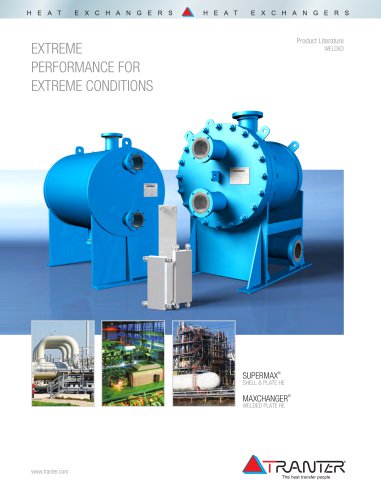
Catalog excerpts

HEAT EXCHANGERS A. HEAT EXCHANGERS The heat transfer people Maintaining a Plate Heat Exchanger Both reactive or proactive approaches to maintenance have advantages and disadvantages. It is up to you to decide which method is best suited Maintaining a plate heat exchanger and its related cost is not just a good idea - it is a necessity for any successful business strategy concerned with its continued manufacturing productivity. It is safe to say that it would be rare to find someone in this industry that does not believe in having a plate heat exchanger maintenance strategy. The key is its scope and effectiveness. When thinking of establishing a maintenance strategy, the tough questions that affect budgets come quickly to • Is it better to eliminate equipment problems after they arise or prevent them from happening? • Equipment failure must happen sometime. Is it better to deal with it in-house or through certified off-site cleaning facilities with original equipment manufactured (OEM) diagnostics, parts and repairs? • Are there real gains or drawbacks to using non-OEM parts? The challenge comes from knowing when to spend on maintenance efforts with a look toward a reasonable return on that investment and when maintenance can be effective through lower-cost methods. This is not necessarily an either/or proposition: It is more of a good balancing act with a look toward the best methods of maintenance to garner the greatest equipment productivity. It is not just spending money on maintenance that leads to effective productivity; it is spending money The hard questions come down to a simple strategy choice: Is your business not just reactive but proactive in its response to maintenance issues? A reactive approach is the most popular method that most manufacturing businesses use to save money short-term; a proactive approach is forward-looking and prepares the business for eventual equipment failure and solving errors before they can affect production downtime or cash flow. The purpose of this article is to look closely at the methods for maintaining a plate heat exchanger - sometimes referred to as a plate-and-frame heat exchanger or PHE - so that it runs as efficiently as possible for as long as possible. Just what is a plate heat exchanger and why, when and how does one provide maintenance for it? A plate heat exchanger is a pack of thin, corrugated metal plates made from any stainless steel or exotic metals with ports for the passage of two fluids between which the heat transfer will occur. The plate pack is assembled between two pressure-retaining frames compressed with tightening This exploded view of a plate heat exchanger shows the costly and time consuming if
Open the catalog to page 1
HEAT EXCHANGERS A. HEAT EXCHANGERS The heat transfer people There are many reasons to schedule regular maintenance. The plate heat exchanger must be allowed to maximize its efficiency as it originally was designed for either heating or cooling at specified pressure drops. Unscheduled production stops are costly and annoying. While heating will cause the most stress on a plate heat exchanger, it is not necessarily true that heating will require more or less maintenance than a cooling system. Furthermore, if it is necessary to restore a unit to the original as-built design parameters or...
Open the catalog to page 2
HEAT EXCHANGERS A. HEAT EXCHANGERS The heat transfer people No system is perfect; no equipment will run without eventual breakdown; and not even the best gauges and meters made can detect every problem before it happens. So, while proactive maintenance is the best method of dealing with unit malfunction, it is not the end-all-and-be-all of maintenance approach. Some surprises will arise, and obviously, reactive maintenance procedures will need to be followed. A hybrid of the two systems is the most realistic course, ensuring the least downtime and least expense in repairs and lost...
Open the catalog to page 3
HEAT EXCHANGERS A. HEAT EXCHANGERS The heat transfer people For all its advantages, be careful when making CIP the exclusive method for maintenance of a plate heat exchanger. CIP has its place, but the drawbacks can be costly. The person performing CIP may not be certified to maintain the equipment. If replacement of gaskets and other parts is deemed necessary, the maintenance staff may not be qualified to do it. The temptation to order non-OEM replacement parts when CIP is used exclusively is further testament to getting into a false sense of cost cutting for effectiveness. Non-OEM parts...
Open the catalog to page 4
HEAT EXCHANGERS A. HEAT EXCHANGERS The heat transfer people A properly maintained plate heat exchanger can provide many trouble-free years of operation. No piece of equipment is perfect, however; every unit will eventually have problems, and if costly downtime and product loss are to be minimized, a maintenance program is one solution. Like every other piece of equipment, plate heat exchangers require maintenance. How you provide that maintenance - proactively before a problem develops or reactively after production has been disrupted - EQUIPMENT COVERED Plate heat exchangers INDUSTRIES...
Open the catalog to page 5All Tranter catalogs and technical brochures
Archived catalogs
-
Shell-and-Plate
3 Pages
-
SUPERCHANGER®
28 Pages
-
Thermofit
4 Pages
-
Parts & Service Brochure
6 Pages
-
Company Brochure English
8 Pages
-
Oil & Gas brochure English
8 Pages
-
Service English
8 Pages
-
Gasketed PHE English
8 Pages
-
Product Brochure English
8 Pages
-
Prime Surface Heat Exchangers
10 Pages


































